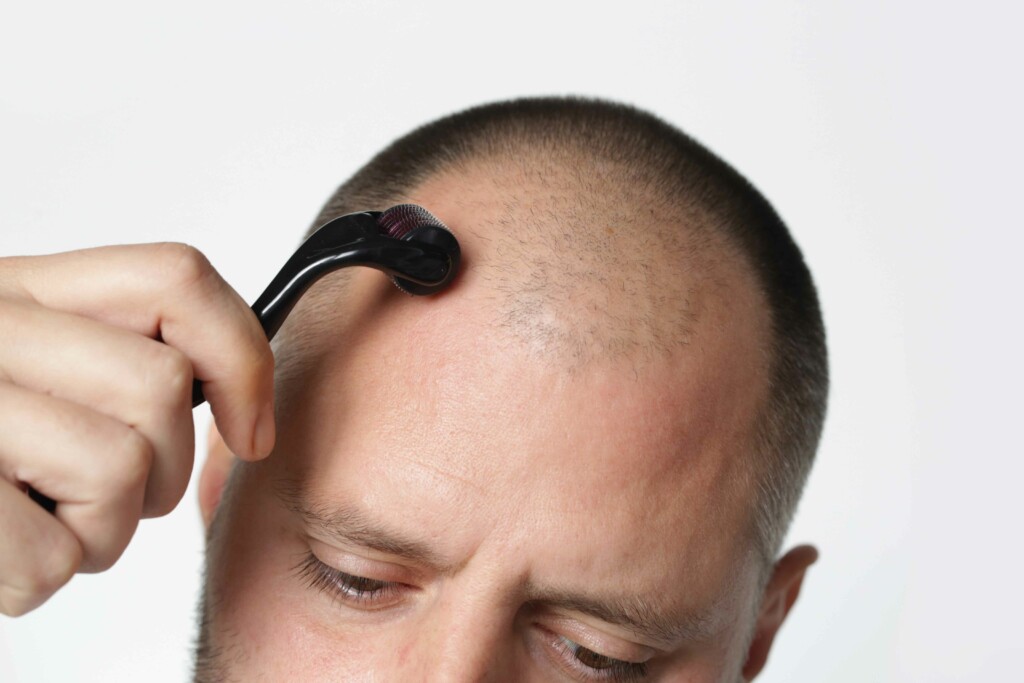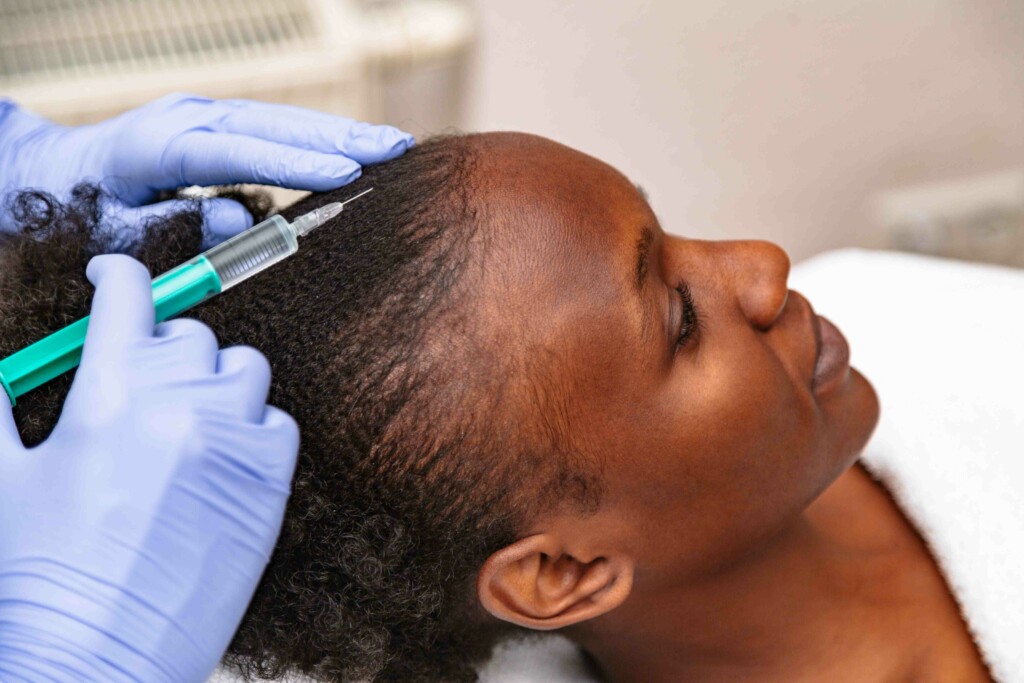If you’re considering getting a hair transplant, you’ve probably been looking at a lot of before and after pictures — as well as pictures of what you’ll look like post-procedure. And chances are that you’ve stumbled on at least one hair transplant picture of a scalp covered in tiny holes.
If pictures of objects with clusters of holes creep you out, you’re not alone. The feeling of disgust, fear, or repulsion when seeing such objects is known as trypophobia. (1) It sometimes occurs when people look at objects that have multiple holes or small seeds that are super close together, like honeycombs, sunflowers, strawberries, and lotus seed pods. When this feeling occurs after seeing hair transplant holes, it’s known as hair transplant trypophobia.
The good news is that these days, hair transplant holes aren’t too common. They’re most common post-procedure for a brief period of time. And fortunately, the chances of your scalp looking anything like the picture you’ve seen online is highly unlikely if you’ve chosen a good surgeon.
What Causes Hair Transplant Holes?
Hair transplant holes are the small holes left behind after hair follicles are extracted during a hair transplantation procedure. These holes are most likely to occur to people who get hair plugs, the original hair transplant surgery technique that’s rarely performed today, or the modernized version of this procedure: follicular unit extraction (FUE).
Hair plugs may also occur depending on the technique used by your surgeon, your surgeon’s skill level, or if complications – like skin infections – occur after your procedure.
What Are Hair Plugs?
Hair plugs are an old-school hair transplant technique. They were the first type of hair transplant surgery to become available, and are essentially a larger-scale version of the FUE technique. These days, they’re rarely performed by hair transplant surgeons. (2-4)
Old hair plugs would involve surgeons taking small punch-holes of skin, which contained multiple hair follicles, extracting them from the scalp. These pieces of skin, which were 4 to 5 millimeters in size and contained as many as 20 hair strands, were then implanted back into the scalp in an area with hair loss. (2)
When these 4 to 5 millimeter punch-holes of skin were extracted, they would leave small circular holes along the back and sides of the scalp. The holes would gradually heal, but given the size of the wounds, this process would take time. And even after, there could still be pitting and scarring around the areas where the hole punches were made. (2)
Transplanting pieces of skin 4 to 5 millimeters in size also required making new holes in the scalp. The surgeon would need to create a hole in the skin large enough to accommodate each hair plug before it could be reinserted into the scalp. The final result ended up giving people tufts of hair around the transplanted areas that made their scalps look a bit like a doll’s head.
These days, the only reason people consider hair plug surgeries is due to affordability. Hair plugs cost far less than more modern-day hair transplant techniques like FUE.
But there’s no doubt about it: Hair plugs look unnatural. Well…unless you want your scalp to look like Barbie’s or Ken’s. And as you might imagine, this technique is particularly awful if you’re considering getting hair plugs for a receding hairline.
What Is FUE?
Follicular unit extraction — also referred to as follicular unit excision — is the modern-day version of hair plugs. Over time, surgeons reduced the size of the hair plugs they were using. This meant that the amount of hair strands per graft were reduced to half the size (around 8 to 10 hair strands) and eventually as little as a quarter of the size (about 3 to 5 hair strands). Eventually, as surgeons became able to consistently extract just 1 or 2 hairs as micrografts, FUE became popularized. (2-4)
Extracting singular hair follicles means that you still end up with hair transplant holes during FUE. However, extracting these hairs — which can be taken from your scalp, chest, or another part of your body — leaves minuscule holes. You’re unlikely to notice them as they start to heal within the first few days after the procedure.
During FUE, your surgeon still needs to create small holes on the parts of the scalp where the hair will be relocated to. But similarly, these intentional wounds are tiny, too.
These days, good practice is for recipient FUE sites to be no larger than 1.7 millimeters. That means that each hole is meant to be no larger than an 18-gauge needle. That’s the same sort of needle used for ear and nose piercings. (2)
The FUE procedure leaves small holes that are cleaned and covered with gauze for the first day or two. In other surgeries, your doctor has to sew or staple wounds shut or seal it with glue. But FUE hair transplants leave such small holes that your body is able to rapidly heal them on its own. As long as your FUE procedure is done by a skilled surgeon, it’s unlikely that you’ll even notice your hair transplant holes – they’ll scab over within a few days and be gone before you know it.
Can All Hair Transplants Leave Holes?
Hair transplant holes are most likely to occur to people who have gotten hair plugs. They’re unlikely to be noticeable after a successful FUE procedure. In rare cases, hair transplant holes may be noticeable post-procedure if your transplanted hair follicles or their extraction sites have gotten infected after your surgery.
Unfortunately, not all FUE hair transplants are performed by skilled surgeons. A bad or cheap FUE surgery is likely to look like a botched hair transplant. It may even cause you to end up with a final result that’s similar to hair plugs.
There’s also another procedure called follicular unit transplantation (FUT) that’s performed as an alternative to FUE. This procedure involves the removal of a strip of skin from the back of your scalp and extracts the hair follicles for transplantation from it. This surgical technique typically leaves a scar, but is unlikely to leave hair transplant holes. Only infection or rejection of the transplanted hair grafts would result in noticeable hair transplant holes following FUT. (2-4)
Minimizing the Risk of Hair Transplant Holes: Hair Plugs vs. Hair Transplants
If you’ve gagged at the picture of a scalp that’s recently had a hair transplant, you’re not alone. Trypophobia of hair transplant holes is a common response. The upside? Hair plugs trypophobia is becoming less and less common since hair plugs are becoming an outdated surgical technique. This procedure often left large holes as it used punch grafts to remove multiple hair follicles at once.
Modern-day hair transplant procedures performed by qualified surgeons won’t make your scalp look like a doll’s head. These surgeries, known as FUE hair transplants, can extract single hair follicles — which range from those producing just single hairs to those producing a few hair strands. Relocating these micrografts from one part of your scalp to another means you’ll hardly notice the tiny holes – and best of all, you’ll end up with a natural-looking hairline transplant.
So if pictures of hair plugs have caused you to second guess getting a hair transplant, don’t worry. Just make sure you choose a qualified, reputable surgeon who has experience performing FUE hair transplants.
References
- Trypophobia: What Is It, Triggers, Symptoms, Diagnosis & Treatment. (n.d.). Cleveland Clinic. https://my.clevelandclinic.org/health/diseases/21834-trypophobia
- Arnold, M. G., & Owen, S. R. (2021). Hair Restoration. Facial Plastic and Reconstructive Surgery: A Comprehensive Study Guide, 337-350.
- Zito, P. M., & Raggio, B. S. (2019). Hair transplantation
- Rose, P. T. (2015). Hair restoration surgery: challenges and solutions. Clinical, cosmetic and investigational dermatology, 8, 361.
Last updated September 2023




